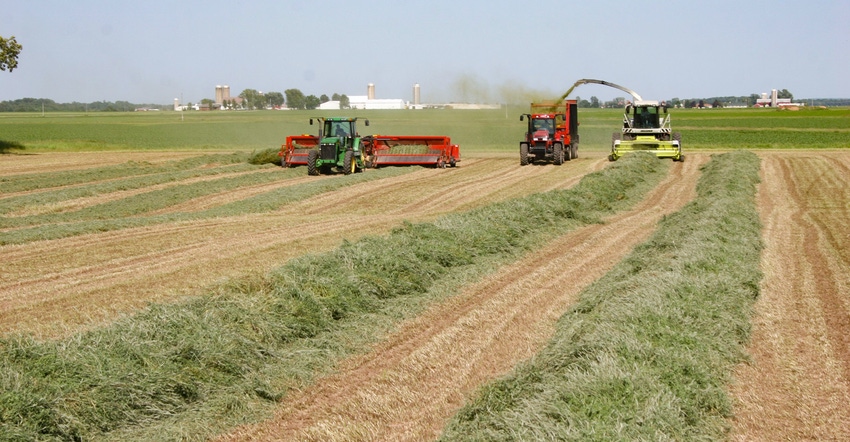May 22, 2020

Summer-seeded alfalfa is a management practice to establish a high-quality stand in fields that were too wet to plant in the spring, or to establish a second crop after a small grain or canning crop. As with any crop, timing of planting, seedbed preparation, fertility management and seed selection are all key in having a high-quality, productive summer-seeded alfalfa stand.
For a successful stand, alfalfa needs to be planted at least 45 days before the first killing frost. This amount of time is necessary for the seedling to develop a crown to store root reserves to survive the winter.
In Wisconsin’s northern tier of counties, summer-seeded alfalfa should be planted no later than the end of July. In the middle of the state, plant no later than mid-August, and in the southern tier of counties, no later than the end of August.
Where to seed
When considering which field to establish a stand in, you must first consider if any herbicides were applied to the initial crop, and if so, what herbicides. All herbicides legally require a period of time called “rotational interval” prior to the planting of a crop that will be used as forage. Not only does this reduce crop injury, but it also protects livestock from residues that may have accumulated in the forage. Rotational interval can range from no interval up to and exceeding 18 months. Information can be found on the herbicide label, or talk with your local Extension agriculture educator or your agronomist.
Establishing an alfalfa stand in summer is similar doing it in spring. Seed should be seeded about a quarter inch deep, but not deeper than a half inch, with a seeding rate of 12 to 15 pounds per acre. Start with a weed-free field through tillage or a burndown herbicide application.
Though tillage is effective in controlling weeds, if overdone, it can also cause the soil to become overly dry. Adequate soil moisture is important for germination and quick canopy formation to outcompete other weeds. Seed will germinate with a half inch or less of rainfall; however, seedlings can die in a matter of days if drought conditions occur after germination. Tillage in August may also cause the seedbed to be lighter and looser. In those cases, two passes to pack the soil may be required.
Unlike spring planting, it is not recommended to plant a companion crop with alfalfa, as the cover will compete with the alfalfa for moisture.
If you use no-till practices due to highly erodible land restrictions or as a preferred management practice, make sure the drill is set to optimize seed-to-soil contact. Most no-till drills used to seed alfalfa have coulters that cut through residue, disk openers, a depth-control mechanism and press wheels to cover the seed firmly.
Test soils
Soil testing is the only way to determine what nutrients need to be applied. Alfalfa requires a soil pH level of 6.8 at the time of planting. Potassium improves winter-hardiness and resistance to disease. Phosphorus aids in establishing plant tissues such as the roots during seedling development. Consult with your local Extension agriculture educator or agronomist on fertility recommendations.
With the various traits available to you, it is important to select an alfalfa variety that fits your management style and also will establish well in summer. Although diseases are not a main concern for seedlings in summer, they may become an issue later in the stand life. Choose a variety that has high resistance to those diseases present in your area.
To improve survival of seedlings over winter, choose a variety that is winter-hardy and has a high resistance to crown and root diseases. Winter survival of seedlings is also affected by a harvest during the fall. This may result in stand losses due to the roots not being established enough to store carbohydrates throughout the summer.
By following these recommendations of planting timing, seedbed preparation, fertility management and variety selection, you can have a productive, high-quality alfalfa stand.
Marzu is a University of Wisconsin-Madison Extension agriculture educator for Lincoln and Langlade counties.
You May Also Like




